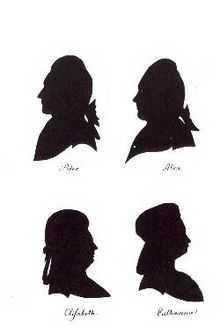Grand Duchess Anna Leopoldovna of Russia
| Grand Duchess Anna Leopoldovna | |||||
|---|---|---|---|---|---|
| Regent of Russia | |||||
.jpg) | |||||
| Reign | 1740–1741 | ||||
| Spouse | Duke Anthony Ulrich of Brunswick | ||||
| Issue among others... | Ivan VI of Russia | ||||
| |||||
| House | House of Mecklenburg-Schwerin | ||||
| Father | Charles Leopold, Duke of Mecklenburg | ||||
| Mother | Catherine Ivanovna of Russia | ||||
| Born |
18 December 1718 Rostock | ||||
| Died |
19 March 1746 (aged 27) Kholmogory | ||||
| Burial | Alexander Nevsky Monastery | ||||
| Religion | Lutheranism, then Eastern Orthodox | ||||
Anna Leopoldovna of Russia (А́нна Леопо́льдовна) (18 December 1718 – 19 March 1746), also known as Anna Karlovna (А́нна Ка́рловна), regent of Russia for a few months (1740–1741) during the minority of her baby son Ivan. She was the daughter of Tsarevna Catherine of Russia (sister of Empress Anna) and of Charles Leopold, the Duke of Mecklenburg-Schwerin and born as Elisabeth Katharina Christine of Mecklenburg-Schwerin.
Background
In 1722, Anna arrived in Russia with her mother, who had escaped and separated from her father: her mother was considered as a candidate to the throne in 1730, but her aunt was chosen instead. In 1733, Anna converted to the Orthodox religion and given the name Anna Leopoldovna, which made her acceptable as an heir to the throne. In 1739 she married Anthony Ulrich (1714–1776), son of Ferdinand Albert, Duke of Brunswick-Wolfenbüttel: he was taken to Russia already in 1733, so that she could get to know him.
On 5 October 1740 the empress Anna adopted their new-born son Ivan and proclaimed him heir to the Russian throne. A few days after this proclamation the empress died (28 October 1740), leaving directions regarding the succession, and appointing her favourite Ernest Biron, Duke of Courland, as regent.
Regency
Biron, however, had made himself an object of detestation to the Russian people, and after Biron had threatened to exile Anna and her spouse to Germany, Anna Leopoldovna had little difficulty in overthrowing him (8 November 1740). She then assumed the regency, and took the title of Grand Duchess, but she knew little of the character of the people with whom she had to deal, knew even less of the conventions and politics of Russian government, and speedily quarrelled with her principal supporters.
According to a Dictionary of Russian History, she ordered an investigation of the garment industry when new uniforms received by the military were found to be of inferior quality. When the investigation revealed inhuman conditions she issued decrees mandating a minimum wage and maximum working hours in that industry as well as the establishment of medical facilities at every garment factory.
She also presided over a brilliant victory by Russian forces at the Battle of Villmanstrand in Finland after Sweden had declared war against her Government. She had an influential favourite, Julia von Mengden.
In December 1741, the daughter of Peter the Great, who, from her habits was a favourite with the soldiers, excited the guards to revolt, overcame the insignificant opposition, and ascended the throne as empress Elizabeth. This coup was supported by the ambassadors of France and Sweden, possibly with financial inducements to members of the Guard's regiments who wanted to change the pro-British and pro-Austrian policies of Anna Leopoldovna's Government.
After the deposition
The victorious regime first imprisoned the family in the fortress of Dünamünde near Riga and then exiled them to Kholmogory on the Northern Dvina river. Anna eventually died on 18 March 1746 during childbirth. Her son Ivan VI was murdered in Shlisselburg on 16 July 1764, while her husband Anthony Ulrich died in Kholmogory on 19 March 1776. Her remaining four children (Ekaterina, Elizaveta, Peter and Alexei[1]) were released from prison into the custody of their aunt, the Danish queen dowager Juliana Maria of Brunswick-Wolfenbüttel, in 30 June 1780 and settled in Jutland, were they lived in comfort under house arrest in Horsens for the rest of their lives under the guardianship of Juliana and at the expense of Catherine the Great: having lived as prisoners, they were not used to social life, and kept a small "court" of 40/50 people, all Danish except for the priest. [2]
Family

Anna Leopoldovna had the following children:
- Ivan VI (1740–1764) (reigning Emperor 1740-1741)
- Catherine Antonovna of Brunswick (1741–1807) (released to house arrest in Horsens in Denmark in 1780)
- Elizabeth Antonovna of Brunswick (1743–1782) (released to house arrest in Horsens in Denmark in 1780)
- Peter Antonovich of Brunswick (1745–1798) (released to house arrest in Horsens in Denmark in 1780)
- Alexei Antonovich of Brunswick (1746–1787) (released to house arrest in Horsens in Denmark in 1780)
Titles and styles
- 18 December 1718 – 3 July 1739: Her Serene Highness Duchess Elisabeth of Mecklenburg-Schwerin
- 3 July 1739 – 8 November 1740: Her Serene Highness Duchess Elisabeth of Brunswick-Wolfenbüttel
- 8 November 1740 – 6 December 1741: Her Imperial Highness Grand Duchess Anna Leopoldovna, Regent of Russia
- 6 December 1741 – 19 March 1746: Her Imperial Highness Grand Duchess Anna Leopoldovna of Russia
Ancestry
| Ancestors of Grand Duchess Anna Leopoldovna of Russia | ||||||||||||||||||||||||||||||||||||||||||||||||||||||||||||||||||||||||||||||||||||||||||||||||||||||||||||||||||||||||||||||||||||||||||||||||||||||||||||||||||||||||||||||||||||||||||||||||||||||||||||||||||||||||||||||||||||||||||||||||||||||||||||||||||||||||||||||||||||||||||||||||||||||||||||||||||||||||||||||||||||||||||||||||||||||||||||||||||||||||||||||||||||||||||||||||||||||||||||||||||||||||||||||||||||||||||||||||||||||||||||||||||||||||||||||||||||||
|---|---|---|---|---|---|---|---|---|---|---|---|---|---|---|---|---|---|---|---|---|---|---|---|---|---|---|---|---|---|---|---|---|---|---|---|---|---|---|---|---|---|---|---|---|---|---|---|---|---|---|---|---|---|---|---|---|---|---|---|---|---|---|---|---|---|---|---|---|---|---|---|---|---|---|---|---|---|---|---|---|---|---|---|---|---|---|---|---|---|---|---|---|---|---|---|---|---|---|---|---|---|---|---|---|---|---|---|---|---|---|---|---|---|---|---|---|---|---|---|---|---|---|---|---|---|---|---|---|---|---|---|---|---|---|---|---|---|---|---|---|---|---|---|---|---|---|---|---|---|---|---|---|---|---|---|---|---|---|---|---|---|---|---|---|---|---|---|---|---|---|---|---|---|---|---|---|---|---|---|---|---|---|---|---|---|---|---|---|---|---|---|---|---|---|---|---|---|---|---|---|---|---|---|---|---|---|---|---|---|---|---|---|---|---|---|---|---|---|---|---|---|---|---|---|---|---|---|---|---|---|---|---|---|---|---|---|---|---|---|---|---|---|---|---|---|---|---|---|---|---|---|---|---|---|---|---|---|---|---|---|---|---|---|---|---|---|---|---|---|---|---|---|---|---|---|---|---|---|---|---|---|---|---|---|---|---|---|---|---|---|---|---|---|---|---|---|---|---|---|---|---|---|---|---|---|---|---|---|---|---|---|---|---|---|---|---|---|---|---|---|---|---|---|---|---|---|---|---|---|---|---|---|---|---|---|---|---|---|---|---|---|---|---|---|---|---|---|---|---|---|---|---|---|---|---|---|---|---|---|---|---|---|---|---|---|---|---|---|---|---|---|---|---|---|---|---|---|---|---|---|---|---|---|---|---|---|---|---|---|---|---|---|---|---|---|---|---|---|---|---|---|---|---|---|---|---|---|---|---|---|---|---|---|---|---|---|---|---|---|---|---|---|---|---|---|---|---|---|---|---|---|---|---|---|---|---|---|---|---|---|---|---|---|---|---|---|---|---|---|---|---|---|---|---|---|---|---|---|---|---|---|---|---|---|---|---|---|---|---|---|
| ||||||||||||||||||||||||||||||||||||||||||||||||||||||||||||||||||||||||||||||||||||||||||||||||||||||||||||||||||||||||||||||||||||||||||||||||||||||||||||||||||||||||||||||||||||||||||||||||||||||||||||||||||||||||||||||||||||||||||||||||||||||||||||||||||||||||||||||||||||||||||||||||||||||||||||||||||||||||||||||||||||||||||||||||||||||||||||||||||||||||||||||||||||||||||||||||||||||||||||||||||||||||||||||||||||||||||||||||||||||||||||||||||||||||||||||||||||||
Sources
-
 This article incorporates text from a publication now in the public domain: Chisholm, Hugh, ed. (1911). "Anna Leopoldovna". Encyclopædia Britannica (11th ed.). Cambridge University Press.
This article incorporates text from a publication now in the public domain: Chisholm, Hugh, ed. (1911). "Anna Leopoldovna". Encyclopædia Britannica (11th ed.). Cambridge University Press.
References
External links
| Wikimedia Commons has media related to Anna Leopoldovna. |
 "Anna Carlovna". The American Cyclopædia. 1879.
"Anna Carlovna". The American Cyclopædia. 1879.
- Romanovs. The fourth film. Anna Ioannovna; Anna Leopoldovns; Elizabeth Petrovna on YouTube – Historical reconstruction "The Romanovs". StarMedia. Babich-Design(Russia, 2013)